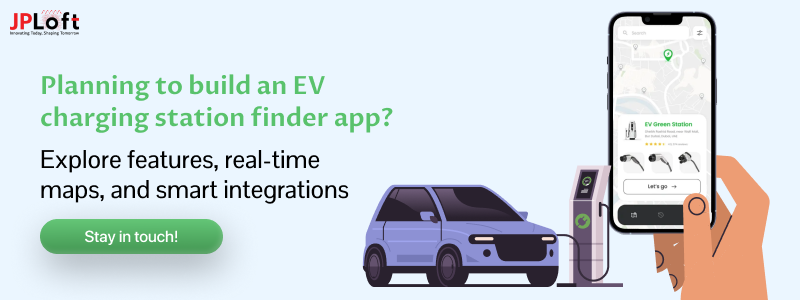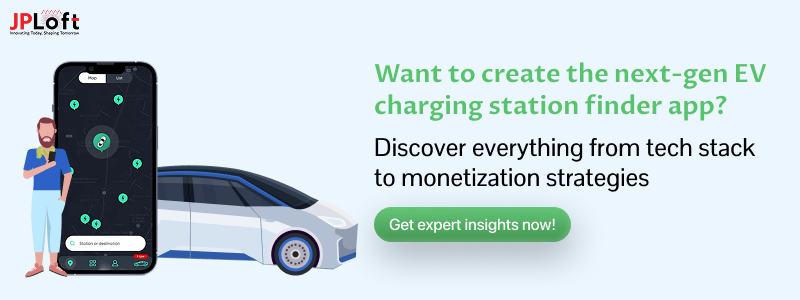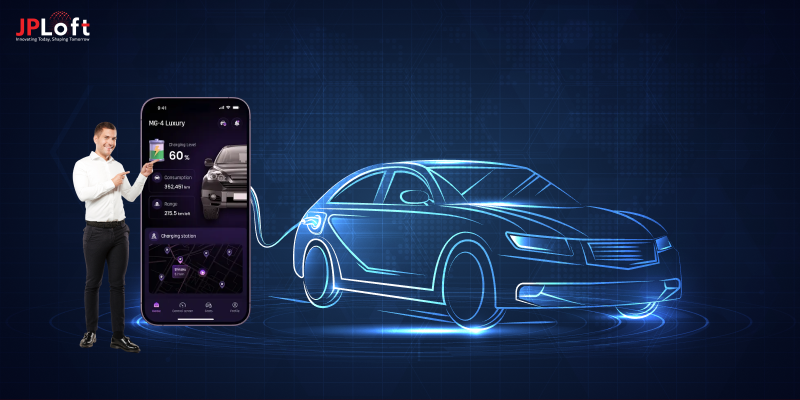“We have a responsibility to create a cleaner and smarter planet for generations to come."
– Sundar Pichai (CEO, Google)
To truly contribute to a sustainable future, many innovators are choosing to build an EV charging station finder app that supports the growing shift toward electric mobility.
However, owning an EV is just half the experience, the other half lies in easily locating nearby, available charging stations with up-to-date status and pricing.
That’s where an electric vehicle charging app steps in, acting as a vital bridge between EV drivers and charging networks. In this guide, we’ll uncover everything you need to know to build a feature-rich, scalable EV charging station finder app.
Let’s dive into it in detail.
Key Takeaways:
With the EV charging infrastructure market set to cross $140B by 2030, now’s the right time to invest in digital solutions.
It helps users locate, book, and pay for nearby EV charging stations with real-time updates and smart navigation.
EV demand is rising, government policies are favorable, and monetization options like ads and subscriptions offer solid ROI.
From design to development, testing, and deployment, every phase shapes performance and scalability.
App costs typically range from $40,000 to $250,000+ based on features, platform, and tech stack.
As a leading EV software development company, JPLoft delivers end-to-end app solutions that are scalable, secure, and user-friendly.
What is an EV Charging Station Finder App?
An EV Charging Station Finder App is a mobile application that helps electric vehicle (EV) owners find nearby charging stations quickly and easily. Just like you use Google Maps to find restaurants or petrol pumps, this app shows real-time locations of EV chargers around you.
It tells you important details like which stations are available, the type of charger they offer, how much it costs, and even if there’s a queue. Some apps also let you book a charging slot, make payments, or track your charging session live.
These apps are a key part of the growing world of electric vehicle software development, where smart tech meets eco-friendly travel.
In short, it’s your travel buddy for smooth and stress-free EV charging, especially useful when you're running low on battery or planning a long trip.
Why to Invest in EV Charging Station Finder App?
If you're planning to develop an EV charging station finder app, now is the perfect time to tap into the booming electric vehicle ecosystem. Here's why EV charging station finder app development is a smart business move:
1. Massive Market Growth
With EV adoption accelerating worldwide, the need for a seamless way to locate charging stations is more critical than ever. By choosing to develop an EV charging station finder mobile app, you position yourself at the center of this growing demand.
2. Fragmented Infrastructure Needs Unification
Charging networks are spread across multiple providers. A well-built app bridges this gap, offering users a one-stop solution, making EV charging station finder app development a valuable digital asset.
3. Multiple Monetization Streams
From premium subscriptions to in-app ads and partnerships with station providers, your app can generate revenue while delivering utility.
4. Eco-Conscious User Base
EV users are tech-savvy and environmentally driven. An intuitive app that helps them locate green or fast-charging stations resonates strongly with this audience.
5. Backed by Government & Industry Trends
With global governments promoting EV infrastructure and automakers investing in connected mobility, there’s strong industry alignment for anyone looking to develop an EV charging station finder app.
6. Opportunity to Lead in Untapped Markets
Many regions lack a comprehensive EV charging locator. Early investment in EV charging station finder app development gives you the first-mover advantage.
In short, when you develop an EV charging station finder mobile app, you're not just building a product, you're contributing to the future of sustainable transportation while unlocking major growth opportunities.
Key Features to Include in an EV Charging Station Finder App
If you're planning to build a smart and future-ready EV Charging Station Finder App, the features you offer can make or break the user experience. These features not only improve functionality but also build user trust and engagement.
Here's a complete list of must-have features of EV apps, explained in detail:
A] Real-Time Charging Station Locator
At the heart of your app is a GPS-based charging station finder. This feature lets users quickly discover nearby EV charging points based on their current location.
It displays important details like distance, directions, and station types, making it an essential tool for everyday EV drivers and road trippers alike.
B] Charging Station Availability Tracking
Nobody likes driving to a charging station only to find it's already in use.
With charging station availability tracking, your app can show live station status, occupied, available, under maintenance, so users can make smarter decisions and avoid wasting time.
C] Filter by Charger Type, Speed, and Compatibility
Give users the ability to filter stations based on charger type (AC, DC, Type 1, Type 2, CCS, CHAdeMO), power output (fast, slow), or compatibility with their specific EV model.
This enhances the app’s usability and supports a wide range of EV owners.
D] Slot Booking and Secure Payments
Let users book a charging slot in advance, especially in high-demand areas. This feature
reduces wait times and offers peace of mind.
Pair it with secure payment gateways to allow users to pay directly through the app, making the whole experience seamless and cashless.
E] Smart Route Planning and Navigation
One of the most useful features in any EV charging station finder app is intelligent route guidance. This allows users to plan trips that include charging stops based on battery levels, charger availability, and travel distance.
When paired with navigation tools like Google Maps or Mapbox, it reduces range anxiety and makes long-distance EV travel worry-free.
F] User Reviews and Station Ratings
Help your users help each other! With a built-in review and rating system, users can share feedback about charging speed, service quality, safety, and overall experience at each location.
This builds a trustworthy EV community within your app.
G] Push Notifications and Smart Alerts
Keep users informed with notifications about their charging session status, nearby available stations, expired bookings, or promotional offers.
Timely alerts improve engagement and user satisfaction.
These features not only make your EV charging station finder app more functional but also create a seamless and user-friendly experience for EV drivers.
By focusing on what users truly need on the go, you can build an app that stands out in the fast-growing electric mobility space.
Step-by-Step Process to Build an EV Charging Station Finder App
Building a successful EV charging station finder app goes beyond just mapping out nearby charging stations, it requires thoughtful planning, modern tech integration, and a user-first mindset.
In 2025, as electric mobility continues to rise, the demand for a reliable, feature-rich electric vehicle charging app is stronger than ever.
Below is a step-by-step process to help you understand how to develop an EV charging app that is scalable, smart, and ready for the real world.
Step 1: Market Research & Competitor Analysis
Before you develop an EV charging station finder app, start with thorough market research. Study leading platforms like PlugShare, ChargePoint, or EVgo. Observe what they do well and identify where they fall short.
This step helps you figure out what users really want from a location-based EV charging app. Whether you’re targeting urban EV drivers or commercial fleet operators, understanding user behavior ensures your product will stand out.
Ask yourself what’s missing in current location-based EV charging apps and think about unique EV app ideas. This early discovery phase ensures that you're not just building another app but solving real user problems with a clear competitive advantage.
Step 2: Define Your Core Features and Functionality
After learning about your target users, outline the core features needed to develop an electric vehicle charging station finder app. These typically include a real-time EV charging station map, live availability tracking, booking systems, secure in-app payments, route planning, user reviews, and alerts.
Want to make an EV charging station finder app truly unique? Add sustainability features like filters for renewable-powered stations.
To execute this correctly, it’s best to partner with professionals in EV charging station finder app development, ideally the best mobile app development company with expertise in EV platforms.
Step 3: UI/UX Design – Keep It Simple and Functional
The user interface of your app needs to be clean, intuitive, and mobile-friendly. Start with effective app wireframing to plan out user flows, and follow it up with app prototyping to test and refine the experience.
Users should be able to find, book, and pay for a charging station in just a few taps. When you create an EV charging station finder app, always remember most users will use it on the go, so speed, simplicity, and ease-of-use are essential.
Smart UX can make or break your app’s success.
Step 4: Connect with Charging Station Networks
To offer real coverage and value, you must partner with as many EV charging station networks as possible. These could be public charging providers, smart city infrastructure platforms, or renewable energy-based operators.
This is a crucial part of electric vehicle charging station finder app development. To streamline these integrations and manage APIs effectively, it's smart to hire dedicated developers with experience in EV software.
This ensures that your app delivers accurate, real-time data across wide regions.
Step 5: Real-Time Data Handling & IoT Integration
A major differentiator of a smart charging app is its ability to provide real-time data.
When planning to build an electric vehicle charging station finder app, integrating IoT in EV charging apps is a game-changer. IoT sensors at stations can update your app in real time with charger availability, speed, downtime, or maintenance status.
A cloud-based backend will sync and store this data efficiently. This makes your EV charging mobile app smarter and helps users avoid the frustration of showing up at a busy or non-functional charger.
Step 6: Testing and Quality Assurance
Before going live, you need app testing rigorously. Your QA team should test it across multiple devices and operating systems to ensure stable performance.
It's important to verify the accuracy of map data, test payment systems for security and smooth transactions, and ensure booking and availability information is updated in real time.
The app should also remain responsive and consistent in low-connectivity areas. Only when your app delivers a glitch-free and seamless experience can you move on to the next stage.
Step 7: Launch the App
After successful testing, prepare for the official launch. Publish your app to the Google Play Store and Submit your app to Apple App Store, complete with compelling descriptions, high-quality visuals, and SEO-friendly keywords.
Post-launch, you should also integrate tools like Firebase or Mixpanel for analytics and crash reporting so you can track performance, user retention, and engagement metrics from day one.
Launching is more than hitting “submit,” it’s about laying the foundation for long-term success in EV charging station finder app development.
Step 8: Post-Launch Support and Iteration
Once your app is live, continuous monitoring and app maintenance service are crucial. Pay attention to user feedback, track app performance, and address bugs or issues as they arise.
Over time, you may need to expand your network coverage, improve existing features, or even add loyalty programs to increase user retention. The most successful EV charging mobile apps evolve with user expectations and emerging technologies.
By staying agile and responsive, you can ensure your EV charging station finder app remains relevant, reliable, and well-loved by its user base.
Building a high-performing such app in 2025 requires a mix of technical excellence, user empathy, and future-ready thinking.
Whether you're a startup, tech founder, or mobility provider, now is the perfect time to invest in a scalable, smart EV charging station finder app that meets the needs of a rapidly electrifying world.
Tech Stack for Building an EV Charging Station Finder App
Choosing the right technology stack is crucial to building a reliable, high-performance, and scalable EV Charging Station Finder App.
From front-end frameworks to location services and payment gateways, every component should be selected based on the app’s goals and future expansion needs.
Here’s a complete breakdown of the recommended tech stack:
|
Category |
Technologies/Tools |
Purpose |
|
Frontend Development |
React Native, Flutter, Swift (iOS), Kotlin (Android) |
To build a responsive, cross-platform or native mobile user interface |
|
Backend Development |
Node.js, Django, Laravel |
To manage server-side operations, APIs, user data, and app logic |
|
Database |
PostgreSQL, MongoDB, Firebase |
For storing user profiles, charging station data, and payment history |
|
Geolocation Services |
Google Maps API, Mapbox, OpenStreetMap |
To locate nearby charging stations and assist in route navigation |
|
Payment Gateway |
Stripe, Razorpay, PayPal |
For enabling secure, in-app payments for charging sessions |
|
Authentication |
Firebase Auth, OAuth 2.0, Auth0 |
To handle secure login, user registration, and third-party authentications |
|
Real-Time Updates |
Firebase Realtime DB, Socket.io |
To show real-time station availability and booking updates |
|
Cloud Services |
AWS, Google Cloud, Microsoft Azure |
For cloud storage, computing, and scalable backend infrastructure |
|
Push Notifications |
Firebase Cloud Messaging (FCM), OneSignal |
To send smart alerts and real-time notifications to users |
|
IoT Integration |
MQTT, Google Cloud IoT Core, Azure IoT Hub |
To connect with charging station hardware for real-time data transfer |
|
Admin Dashboard |
React.js, Angular, Vue.js + Chart.js, D3.js |
For station owners and admins to manage listings, user data, and analytics |
|
Analytics & Monitoring |
Google Analytics, Firebase Analytics, Datadog |
To track app performance, user behavior, and technical metrics |
This tech stack is flexible and scalable, allowing you to build a reliable electric vehicle charging app that supports everything from station finding to real-time updates and seamless payment.
By leveraging powerful tools like geolocation, cloud platforms, and IoT in EV charging apps, you can create a smart and future-proof solution that meets user needs today and scales for tomorrow.
Challenges in EV Charging Station Finder App Development
When you set out to build an EV charging station finder app, there are several technical and operational challenges that developers must address to ensure a seamless user experience.
Here are some of the biggest EV challenges:
1. Data Accuracy & Real-Time Updates
One of the biggest hurdles when you develop an EV charging station finder app is ensuring live availability, station status, and dynamic pricing. Many networks provide inconsistent or outdated data, making real-time accuracy a real challenge.
2. Integration with Diverse Charging Networks
Multiple charging providers operate independently with their own APIs. To create an EV charging station finder app that offers a unified experience, developers must integrate these diverse systems, a complex and time-consuming task.
3. Location-Based Services & GPS Accuracy
Accurate mapping and real-time navigation are must-haves. While you build an EV charging station finder app, advanced GPS and location-based services are essential for helping users find the closest available chargers.
4. User Trust & Payment Security
When users make payments through the app, secure payment gateways and transparent billing become critical. To develop an EV charging station finder app users can trust, strong encryption and PCI compliance are non-negotiable.
5. UI/UX Complexity
EV users often interact with the app while driving or under time pressure. Designing a clean, intuitive, and distraction-free UI is essential when you create an EV charging station finder app that’s truly user-friendly.
Overcoming these challenges requires deep domain expertise, strong tech infrastructure, and collaboration with hardware and network providers.
Cost to Develop an EV Charging Station Finder App
The cost to develop an EV charging station finder app typically ranges from $40,000 to $250,000+, depending on various factors such as design complexity, features, location of the development team, and tech stack.
A basic version with essential EV charging app features like station locator, booking, and payment integration may start around $40,000–$60,000.
However, if you want to include advanced functionalities such as IoT integration, real-time data mapping, AI-based suggestions, and renewable energy compatibility, the price can quickly rise to $150,000–$250,000+.
It's also important to consider post-launch support, maintenance, and updates, which can influence long-term costs. Here’s a quick breakdown of the potential costs:
|
App Component |
Estimated Cost Range |
Short Description |
|
UI/UX Design |
$5,000 – $15,000 |
Designing user-friendly and visually appealing interfaces |
|
Core Development (Frontend + Backend) |
$15,000 – $80,000 |
Main architecture including user app, server, and APIs |
|
Real-Time EV Charging Station Map |
$10,000 – $25,000 |
Live location tracking and availability updates |
|
IoT & Sensor Integration |
$8,000 – $20,000 |
Connects with charging hardware for real-time data |
|
Location & Navigation APIs |
$4,000 – $10,000 |
Enables route planning and nearby station suggestions |
|
Payment Gateway Integration |
$3,000 – $8,000 |
Allows users to pay for charging directly via the app |
|
Admin Panel & Dashboard |
$5,000 – $15,000 |
Backend interface for managing users, stations, and reports |
|
Testing & QA |
$3,000 – $10,000 |
Ensures the app is bug-free and performs across all devices |
|
Post-launch Support & Maintenance |
$2,000 – $8,000/month |
Ongoing updates, monitoring, and issue resolution |
This is a clear understanding of your app’s goals and feature priorities that will help you estimate the right budget. Always plan for scalability and long-term support when calculating your investment.
Monetization Strategies for EV Charging Station Finder Apps
Want to build an EV charging station finder app that doesn't just help users, but also earns you money? Here are some smart monetization strategies to consider:
-
Freemium Model: Start with free basic features and offer upgrades like route optimization, priority bookings, or an ad-free experience through a paid subscription.
-
In-App Advertising: Display subtle ads from EV brands, energy providers, or nearby businesses. Use clean banners or native ad formats that won’t disrupt the user experience.
-
Partner Commissions: Create an EV charging station finder app that earns a cut each time a user books a charging session through your partner networks or aggregators.
-
Fleet Subscription Plans: Offer special packages for logistics companies and fleet owners with features like real-time tracking, analytics, and bulk slot booking.
-
Data Monetization: With user consent, collect and anonymize data on travel and charging patterns. Sell these insights to EV companies, urban planners, or energy providers.
-
Featured Listings: Let station operators pay to rank higher on search results or maps, giving them more visibility while you generate recurring income.
No matter how you make an EV charging station finder app, these monetization strategies will ensure that your platform remains profitable and scalable.
Future of EV Charging Station Finder Apps in 2025
If you're wondering how to build an EV charging station finder app that stays relevant in the coming years, here’s a glimpse into what the future looks like:
-
Real-Time Station Availability: Users will see live updates on charger availability, estimated wait times, and working status, no more surprises on the road.
-
Wider Map Coverage: As you create an EV charging station finder app, expect better GPS accuracy and expanded station listings, even in rural or remote areas.
-
Advanced Filtering Options: Users can filter by charging speed, connector type, pricing, available amenities, or even user ratings, helping them find what fits best.
-
Multi-Network Integration: The best apps will combine data from various charging providers, allowing seamless bookings without switching between platforms.
-
Offline Functionality and Smart Alerts: Even without internet access, your app will show saved station info and notify users about nearby stations while driving.
-
AI-Powered Suggestions: Apps will recommend charging stops based on battery level, current traffic, and past driving habits.
Knowing how to create an EV charging station finder app that is future-ready means leveraging technology, user feedback, and network expansion. As EV demand accelerates, staying ahead of these trends will make your app a key part of every EV owner's journey.
Looking to Build an EV Charging Station Finder App? JPLoft Has You Covered
When it comes to building a high-performance, user-centric EV charging station finder app, experience matters. At JPLoft, we bring years of expertise in building smart, scalable, and secure EV charging solutions tailored to your business model.
As a leading EV software development company, we provide end-to-end services from UI/UX design and API integration to location-based services, IoT integration, and cloud backend management.
Whether you're a startup, enterprise, or utility provider, our expert team ensures your app meets both market demand and user expectations.
With a proven track record in on-demand and energy-related mobile apps, we don’t just code, we deliver digital products that perform. Choose us to power your vision with innovation and unmatched quality.
Final Wrap-Up
As the world shifts toward sustainable transportation, the demand for intelligent, real-time EV charging solutions is booming. Building an EV charging station finder app is not just a business opportunity, it's a step toward shaping a cleaner, smarter future.
By understanding user needs, integrating essential features, and using the right tech stack, you can build an app that truly stands out. And with the support of an experienced company, your idea can turn into a powerful product that accelerates growth and user engagement.
Now’s the perfect time to enter the EV mobility space, start your journey with confidence and innovation.
FAQs
An EV charging station finder app helps electric vehicle users locate nearby charging stations in real-time, check availability, filter based on connector types, and book slots instantly.
The cost varies based on features, platform (iOS/Android), design complexity, and development team location. On average, it ranges from $40,000 to $250,000+.
Key features include a real-time charging station map, live status updates, booking system, route navigation, in-app payments, push notifications, and user reviews.
It typically takes 3 to 6 months depending on the complexity, features, and the experience level of your development team or EV software development company.
Yes, IoT integration enhances real-time communication between charging stations and users, enabling live updates on charging status, equipment health, and remote management.













Share this blog